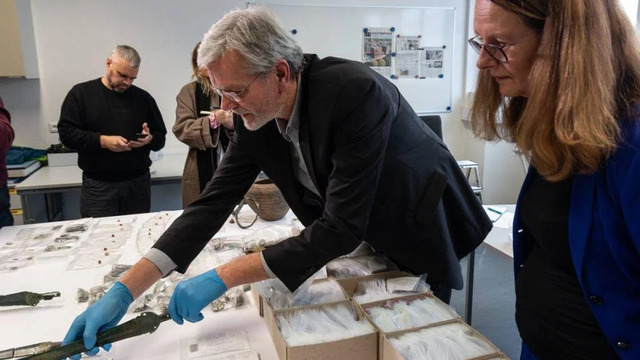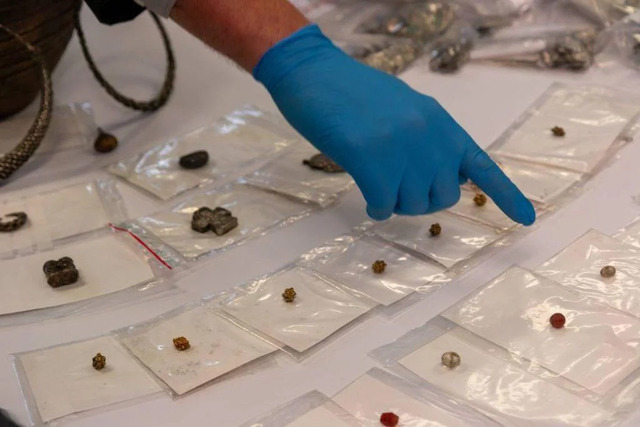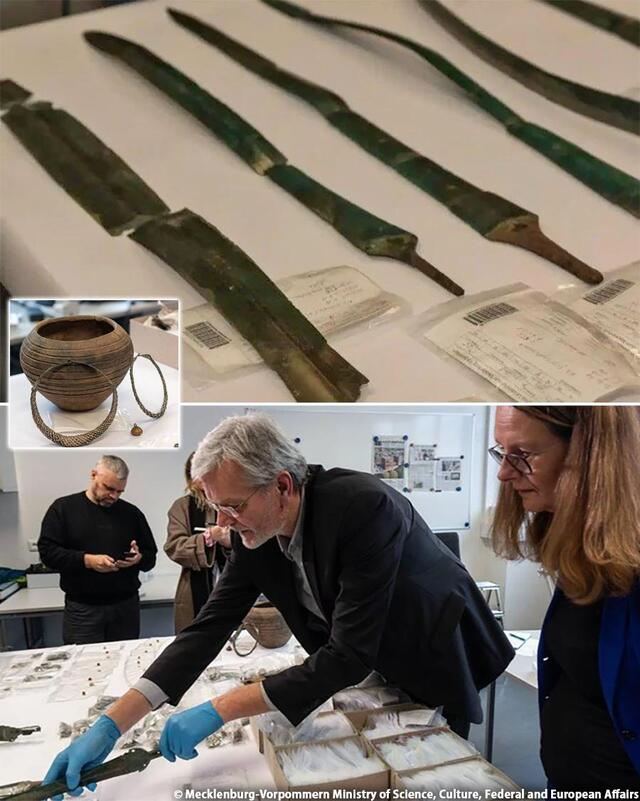Discovering artifacts from the past is like peeling back the layers of time, revealing stories of cultures and civilizations that shaped our history. In recent months, Germany has witnessed a groundbreaking series of archaeological discoveries, thanks to dedicated volunteer conservationists. Among these findings are seven Bronze Age swords, thousands of medieval silver coins, and rare Christian relics—each offering a window into the lives, beliefs, and trade practices of ancient societies. This article delves into these remarkable discoveries, their historical significance, and the efforts of those who brought them to light.
The Bronze Age Swords of Mirow
The first significant discovery occurred near the town of Mirow in northern Germany, where fragments of seven Bronze Age swords—dating back approximately 3,000 years—were unearthed. These swords, believed to have been buried as sacrificial offerings, were likely damaged due to dredging activities in the area.

Archaeologists and state conservationists painstakingly reconstructed the weapons, revealing their intricate craftsmanship and challenging assumptions about the concentration of such artifacts in Mecklenburg-Western Pomerania. The swords’ burial as offerings reflects the spiritual practices of Bronze Age societies, who often associated weapons with rituals of protection, power, and reverence for deities.
Germany’s Minister of Science, Culture, and Federal Affairs, Bettina Martin, praised the dedication of volunteers who contributed to this discovery, emphasizing their invaluable role in preserving the region’s cultural heritage.
The Slavic Coin Hoard of Rügen
A separate discovery on the island of Rügen, approximately 120 miles north of Mirow, brought to light a treasure trove of nearly 6,000 medieval silver coins. This hoard is considered the largest collection of Slavic coins from the 11th century ever found in the post-war era.
Stored predominantly in a clay pot, with some scattered in the surrounding soil, the coins bear origins from diverse regions, including western Germany, England, Denmark, Bohemia (modern-day Czech Republic), and Hungary. This variety underscores the complexity of trade networks during the medieval period.
The coins reveal that the 11th century was a time of robust economic and cultural exchange, connecting distant regions through trade. The scale of the hoard also highlights the importance of Rügen as a hub for commerce and interaction between different societies.


Christian Relics and Medieval Artifacts in Mölln
The town of Mölln provided yet another remarkable find, featuring a collection of 11th-century artifacts that shed light on the spread of Christianity in medieval Germany. Among the discoveries were a pot containing 1,700 coins, a gold and gemstone pearl necklace, finger and neck rings, and two reliquary containers.
One reliquary container, known as a “kaptorga,” and another shaped like a crucifix suggest the growing influence of Christianity in a region still characterized by diverse religious practices. These relics demonstrate how religious symbols were becoming integral to daily life and cultural identity during this period.
The artifacts from Mölln provide a fascinating glimpse into the spiritual and material lives of medieval communities. They highlight the coexistence of emerging Christian practices alongside older traditions, reflecting a transitional phase in the region’s cultural history.

The Role of Volunteer Conservationists
At the heart of these extraordinary discoveries is the tireless work of volunteer conservationists, whose dedication to preserving Germany’s heritage has been nothing short of heroic. Minister Bettina Martin acknowledged their contributions, stating that around 250 volunteers are actively engaged in archaeological monument preservation, with an equal number currently undergoing training.
Their work exemplifies the importance of community involvement in uncovering and protecting historical treasures. These volunteers not only assist professional archaeologists but also help foster a deeper connection between local communities and their shared history.
Cultural and Historical Insights from the Finds
Each of these discoveries offers valuable insights into different periods of human history:
- Bronze Age Rituals: The swords from Mirow reveal the spiritual and ceremonial significance of weapons in ancient societies, emphasizing the role of ritual offerings in their belief systems.
- Medieval Trade Networks: The coins from Rügen paint a vivid picture of the extensive trade routes that connected Europe during the 11th century, demonstrating the interconnectedness of medieval societies.
- Religious Transition: The Christian relics from Mölln highlight the gradual spread of Christianity in a region still influenced by older, pre-Christian traditions.
These findings collectively underscore the diversity and complexity of human culture across millennia.
Implications for Future Archaeological Research
The discoveries in Mirow, Rügen, and Mölln challenge existing assumptions and open new avenues for research. The reconstruction of the Bronze Age swords suggests that Mecklenburg-Western Pomerania may have been more central to ancient trade and cultural exchange than previously thought.
Similarly, the Slavic coin hoard raises questions about the scale and organization of medieval trade networks, while the Christian relics invite further exploration of religious transitions in northern Europe. Continued collaboration between professionals and volunteers will be essential in unraveling these mysteries.
Conclusion
The unearthing of Bronze Age swords, medieval coins, and Christian relics in Germany is a testament to the enduring power of history to inspire and inform. These artifacts, brought to light through the dedication of volunteer conservationists and professional archaeologists, offer a rich tapestry of insights into the spiritual, economic, and cultural lives of our ancestors.
As we continue to piece together the puzzle of the past, discoveries like these remind us of the importance of preserving our shared heritage—for they are not just relics of bygone eras, but stories waiting to be told.
